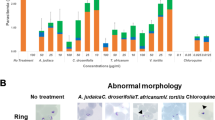Abstract
Malaria is still a major threat in many parts of the world with resistance spreading to almost all classes of antimalarials. The limited arsenal of available antimalarial drugs emphasizes the urgent need for novel antimalarial compounds. Owing to the fact that novel leads from nature have traditionally played a pivotal role in the development of various classes of antimalarials, we investigated a set of eight naturally occurring dietary flavonoids and their analogues for their antiplasmodial activity on clinical field isolates in southeastern Bangladesh and culture-adapted chloroquine-sensitive and chloroquine-resistant parasite clones. Except for taxifolin, all the other flavonoids had 50% inhibitory concentrations below 14 μM, both in the field and laboratory-adapted parasites. Neither of the flavonoids showed any activity correlation with chloroquine. The quercetin analogue rutin (7.10 ± 10.32 μM) was the most active substance in field isolates as well as laboratory-adapted cultures (3.53 ± 13.34 μM in 3D7 and 10.38 ± 15.08 μM in K1), providing the first evidence of its activity against Plasmodium falciparum parasites. Thus, our results provide important evidence of the antimalarial activity of flavonoids in traditional use and thus warrant further investigation of these compounds as potential antiplasmodial agents.


Similar content being viewed by others
REFERENCES
Bruce-Chwatt LJ (1982) Qinghaosu: a new antimalarial. Br Med J (Clin Res Ed) 284(6318):767–768
Cook NC, Samman S (1996) Falvonoids—chemistry, metabolism, cardioprotective effects and dietary sources. J Nutr Biochem 7(2):66–76
de Monbrison F et al (2006) In vitro antimalarial activity of flavonoid derivatives dehydrosilybin and 8-(1;1)-DMA-kaempferide. Acta Trop 97(1):102–107
DeWeerdt S (2011) Food: the omnivore’s labyrinth. Nature 471(7339):S22–S24
Ferreira JF, Luthria DL, Sasaki T, Heyerick A (2010) Flavonoids from Artemisia annua L. as antioxidants and their potential synergism with artemisinin against malaria and cancer. Molecules (Basel, Switzerland) 15(5):3135–3170
Gopiesh Khanna V, Kannabiran K, Rajakumar G, Rahuman AA, Santhoshkumar T (2011) Biolarvicidal compound gymnemagenol isolated from leaf extract of miracle fruit plant, Gymnema sylvestre (Retz) Schult against malaria and filariasis vectors. Parasitol Res 109(5):1373–1386
Havsteen BH (2002) The biochemistry and medical significance of the flavonoids. Pharmacol Ther 96(2–3):67–202
Hollman PC, Bijsman MN, van Gameren Y, Cnossen EP, de Vries JH, Katan MB (1999) The sugar moiety is a major determinant of the absorption of dietary flavonoid glycosides in man. Free Radic Res 31(6):569–573
Kaur K, Jain M, Kaur T, Jain R (2009) Antimalarials from nature. Bioorganic Med Chem 17(9):3229–3256
Kraft C, Jenett-Siems K, Siems K, Gupta MP, Bienzle U, Eich E (2000) Antiplasmodial activity of isoflavones from Andira inermis. J Ethnopharmacol 73(1–2):131–135
Kren V, Walterova D (2005) Silybin and silymarin—new effects and applications. Biomedical papers of the Medical Faculty of the University Palacky, Olomouc, Czechoslovakia 149(1):29–41
Kuhnau J (1976) The flavonoids. A class of semi-essential food components: their role in human nutrition. World Rev Nutr Diet 24:117–191
Lehane AM, Saliba KJ (2008) Common dietary flavonoids inhibit the growth of the intraerythrocytic malaria parasite. BMC Res Notes 1:26
Noedl H, Wernsdorfer WH, Miller RS, Wongsrichanalai C (2002) Histidine-rich protein II: a novel approach to malaria drug sensitivity testing. Antimicrob Agents Chemother 46(6):1658–1664
Noedl H, Attlmayr B, Wernsdorfer WH, Kollaritsch H, Miller RS (2004) A histidine-rich protein 2-based malaria drug sensitivity assay for field use. AmJTrop Med Hyg 71(6):711–714
Noedl H, Se Y, Schaecher K, Smith BL, Socheat D, Fukuda MM (2008) Evidence of artemisinin-resistant malaria in western Cambodia. N Engl J Med 359(24):2619–2620
Noedl H, Socheat D, Satimai W (2009) Artemisinin-resistant malaria in Asia. N Engl J Med 361(5):540–541
Saxena SPN, Jain DC, Bhakuni RS (2003) Antimalarial agents from plant sources. Curr Sci 85(9)
Silveira P, Vashist U, Cabral A, Amaral KB, Soares GL, Dagosto M (2009) Effect of rutin and chloroquine on White Leghorn chickens infected with Plasmodium (Bennettinia) juxtanucleare. Trop Anim Health Prod 41(7):1319–1323
WHO (2010) World Malaria Report 2010. WHO Global Malaria Programme, World Health Organisation, Geneva
Yenesew A et al (2003) Flavonoids and isoflavonoids with antiplasmodial activities from the root bark of Erythrina abyssinica. Planta Med 69(7):658–661
Acknowledgments
We thank all the study participants, the staff of the Sardar Hospital Bandarban, the Civil Surgeon’s Office Bandarban, the Ministry of Health and Family Welfare, and the local community for their support and cooperation. The authors would like to thank Prof. Hans Goldenberg and Medical University Vienna for their kind financial support for Deepa Ganesh. This study was supported by the Malaria Research Initiative Bandarban (MARIB).
Author information
Authors and Affiliations
Corresponding author
Rights and permissions
About this article
Cite this article
Ganesh, D., Fuehrer, HP., Starzengrüber, P. et al. Antiplasmodial activity of flavonol quercetin and its analogues in Plasmodium falciparum: evidence from clinical isolates in Bangladesh and standardized parasite clones. Parasitol Res 110, 2289–2295 (2012). https://doi.org/10.1007/s00436-011-2763-z
Received:
Accepted:
Published:
Issue Date:
DOI: https://doi.org/10.1007/s00436-011-2763-z




